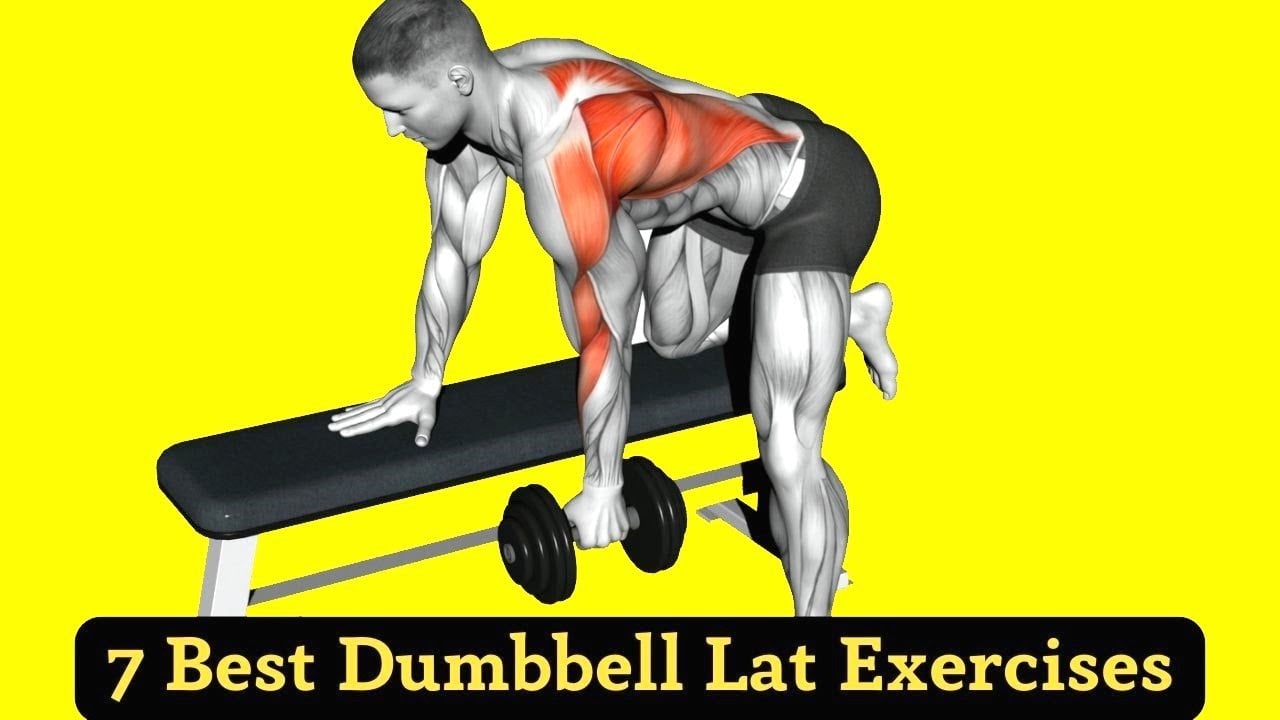The dumbbells are the heroes of lats training. With a little creativity, you can use them to target your lats, which helps build V-taper back.
Dumbbell lat exercises are a great way to train the lats at home or in a gym with limited equipment.
I used to believe that building a strong lat would require endless cable rows and pulldowns. But once you started doing dumbbell exercises, it changed everything. Not only did my lat size improve, but I also gained strength.
By the end of this article, you will know how to perform each exercise correctly to strengthen your lat muscles.
Want to take your gains to the next level? Discover your daily calorie needs with our free TDEE calculator
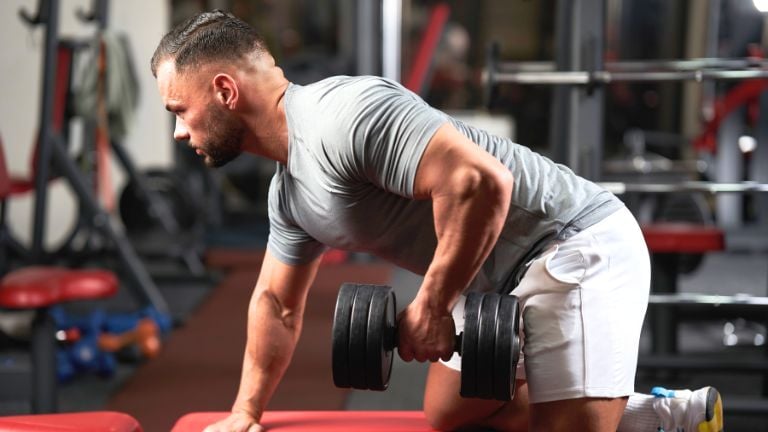
- 7 Best Dumbbell Lat Exercises
- 1. One Arm Dumbbell Row
- 2. Bent Over Dumbbell Row
- 3. Dumbbell Pullover
- 4. Incline Dumbbell Row
- 5. Renegade Row
- 6. Dumbbell Deadlift
- 7. Dumbbell Seal Row
- How To Train Lat With Dumbbell
- Choose Your Lat Training Goal
- Select Training Volume As per Fitness Level
- Beginner Dumbbell Lat Workout Plan
- Intermediate Lat Workout
- Anatomy of the Lats
- Conclusion
7 Best Dumbbell Lat Exercises
Here are 7 of the best dumbbell lats exercises to add to your workout routine to build a bigger and stronger back.
1. One Arm Dumbbell Row
One arm dumbbell rows are a strength exercise that works your back muscles, specifically targeting your lats, rhomboids, and traps.
This exercise can be done with a single dumbbell that helps to work on each side independently, thereby providing better muscle isolation and a longer range of motion.
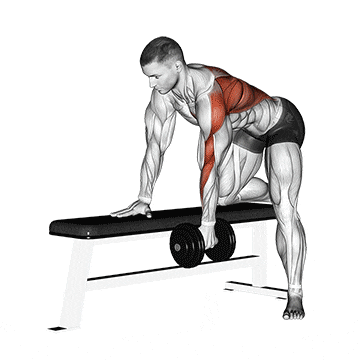
How To Do
- Hold a dumbbell in your left hand. Bend over and place your right knee and right hand on a bench to support your body weight.
- Position your right hand directly under your shoulder. Keep your knees directly under your hips.
- Maintain a flat back and keep your head aligned with your spine.
- Exhale and slowly pull the dumbbell upwards. Keep pulling the dumbbell until you can’t lift more without rotating your torso.
- Inhale and gently lower the dumbbell to your starting position.
Tips
- Keep your core engaged to maintain proper form and avoid swinging the weight.
- Maintain a flat back and retracted shoulder position.
- Avoid rotating your body or changing the position of your spine during the lift.
- Make sure to keep your shoulder blades pulled together throughout the exercise.
2. Bent Over Dumbbell Row
The bent-over dumbbell row is one of the best dumbbell exercises for building bigger and stronger lat muscles.
It is a compound exercise that targets multiple muscle groups, including the back, shoulders, arms, and core. Bodybuilders and fitness enthusiasts love it because it builds strength and muscle in the upper body.
As you stabilize your body during the movement, the core muscles, especially the abdominals and obliques, are also worked.
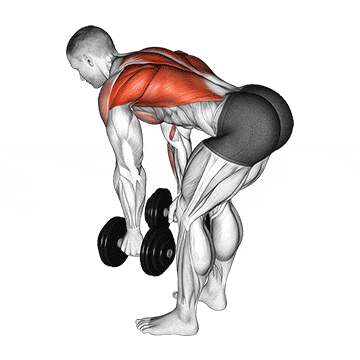
How To Do
- Stand with a narrow stance and hold a dumbbell with a neutral grip in each hand.
- Hinge forward at your hips while keeping your back straight
- Let your arms hang straight down towards the floor, with the dumbbells in front of your knees.
- Pull the dumbbells towards your torso. Try to bring the dumbbells to the level of your rib cage or a little lower.
- Slowly lower the dumbbells back to the starting position.
- Do 8–12 reps and 3–4 sets
Tips
- Maintain a flat back: don’t round the lower spine.
- To protect the spine and enhance stability, contract your abdominal muscles.
- Avoid swinging the dumbbells.
3. Dumbbell Pullover
The dumbbell pullover is a classic strength training exercise that primarily targets the upper body’s muscles, including the latissimus dorsi, chest (pectoralis major), and triceps.
The deep stretch during the eccentric (lowering) phase promotes flexibility and expansion in the rib cage and lats.
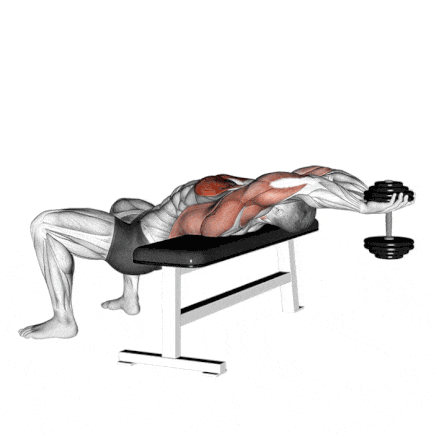
How To Do
- Lie on a flat bench with your feet flat on the floor and your head hanging off the end of the bench.
- Hold a dumbbell in both hands with an overhand grip and your hands.
- Now, raise the dumbbell straight up over your chest until your arms are fully extended.
- Slowly lower the dumbbell behind your head.
- Pause at the bottom of the movement for a brief stretch.
- Then, slowly raise the dumbbell back to the starting position.
Tips
- Choose a weight that allows you to perform all reps with proper form.
- Do not bend at the elbows.
- Don’t go too deep if you feel extreme shoulder tension.
4. Incline Dumbbell Row
The incline dumbbell row, also called the chest-supported row, specifically targets the upper lats and rhomboids.
The incline position lessens the strain on your lower back compared to a standard bent-over row. It helps you do it correctly and avoid rocking in the middle of your row.
Keeping your chest on the bench will eliminate momentum and work your desired muscles.

Read More: How To Perform The Chest Supported Row And Its Variations
How To Do
- Set an incline bench to a 30-45 degree angle.
- Grab a dumbbell in each hand with a neutral grip (palms facing each other).
- Lie face down on the bench with your chest pressed against the pad and your feet planted firmly on the ground.
- Let the dumbbells hang freely below your shoulders.
- Pull the dumbbells up towards your upper body. Your elbows should pass close to your body.
- Hold this position briefly before returning the dumbbells to the starting position.
Tips
- Keep movement under control, and don’t let gravity take you down faster.
- As you pull the dumbbells towards your body, don’t hyperextend the thoracic spine.
- Try to pinch your shoulder blades together at the top.
- Be careful not to choose a weight that’s too heavy.
5. Renegade Row
The renegade row is a full-body exercise that targets the primary muscle groups of the lats, shoulders, and core while also engaging the triceps, biceps, and legs.
It is a variation of the traditional plank exercise that adds resistance by incorporating a rowing movement with dumbbells.
You can increase the intensity of this exercise by trying renegade row push up.
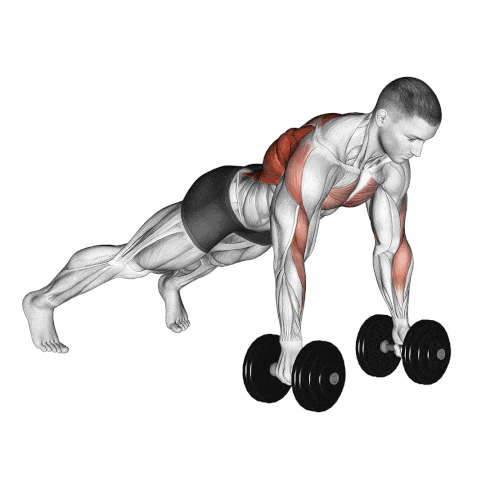
How To Do
- Start by positioning yourself in a plank position with a pair of dumbbells placed on the floor underneath your shoulders.
- Engage your core and maintain a neutral spine by squeezing your glutes and keeping your hips level.
- Begin the exercise by rowing one dumbbell up to the side of your chest.
- Keep your elbow close to your body. And try to squeeze your shoulder blade toward your spine as you lift the weight.
- Lower the dumbbell back down to the starting position.
- Perform the row with your other arm, and this completes one repetition.
Tips
- Focus on squeezing your shoulder blades together as you lift the weight.
- Make sure to start with a weight you can control and maintain proper form.
- Keep your elbows close to your body as you lift the weight.
6. Dumbbell Deadlift
The deadlift is the King of all exercises, and It is a powerful exercise designed to build an overall physique that uses more muscles than any other lat exercise.
The dumbbell deadlift is the best exercise for strengthening posterior chain muscles, including the lat, erector spine, glutes, and hamstrings.
You can do the deadlift with either a barbell or a set of dumbbells. One of the biggest advantages of using dumbbells for deadlifts is that you can work with a wider range of motion than with barbell deadlifts.
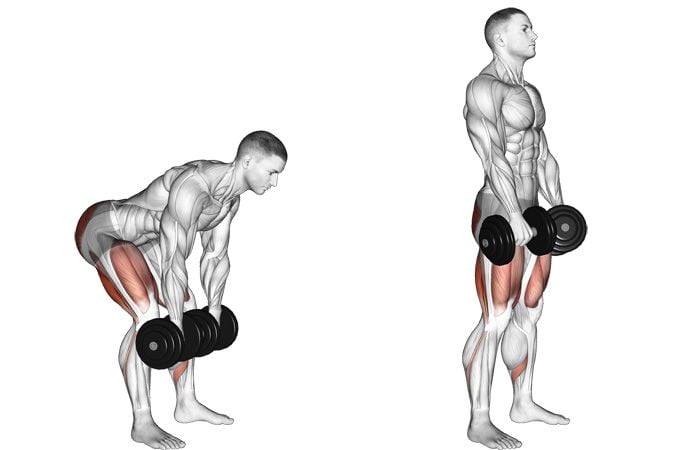
How To Do
- Place a dumbbell in front of you. Grab the dumbbells with each of your hands.
- Remember to keep your back as straight as possible and contract your back and hamstrings.
- Raise the dumbbell from the ground using your hamstrings and glutes.
- You should keep your legs slightly bent, your back straight, and your head looking up.
- Raise it to the point where your body is erect. Do not hyperextend your body as the weight shifts to the lumbar spine.
- Hold the dumbbell for a moment at the top of the lift.
- Now, lower the dumbbell slowly at a steady, slow pace by bending at the hips first and then at the knees.
- Let the weight almost touch the ground briefly before you begin the next rep.
Tips
- If performed incorrectly, the deadlift can cause more harm than good. Keep the back straight at all costs.
- The lower back muscles take a long time to recuperate; therefore, heavy deadlifts should only be done once a week.
- Go with the full range of motion and keep the form correct.
- Avoid jerky movements and keep motion controlled.
7. Dumbbell Seal Row
The dumbbell seal row is a variation of the traditional row. It is designed to isolate the lat muscles without pressure on the lower back.
It is performed lying face down on an elevated bench, eliminating the possibility of using momentum. This ensures a pure and effective back workout.
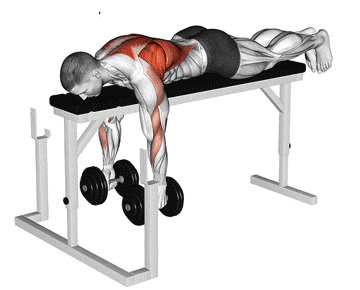
How To Do
- Lie face down on the bench with your chest near the top edge, legs straight, and feet resting on the ground.
- Hold a dumbbell in each hand with a neutral grip (palms facing each other).
- Let the dumbbells hang straight down from your shoulders.
- Row the dumbbells upwards by squeezing your shoulder blades together and bending your elbows.
- Slowly lower the dumbbells back to the starting position.
- Perform for the desired number of reps.
Tips
- Keep your core and spine stable as you pull the dumbbells.
- Keep your elbows closer to your body.
To Stay Motivated: 150+ Gym Workout Motivational Quotes To Stay Fit
How To Train Lat With Dumbbell
You can target all areas of the lats muscles using dumbbells from different angles and through a full range of motion.
Choose Your Lat Training Goal
To structure an effective lat workout with dumbbells to increase mass and strength, the number of reps and sets will vary based on your fitness level, weekly workout frequency, and strength training goals.
- For strength gains, do 4 to 6 sets of 1 to 6 reps for each exercise, using a weight of at least 85% of your one-repetition maximum (1RM). The fewer reps you perform, the closer to 100% of your 1RM you should aim.
- If your goal is hypertrophy (muscle growth), perform three sets of 8 to 12 reps of each exercise, using weights that are 70 to 85% of your 1RM.
- When training for muscular endurance, it is usually recommended to use higher reps (15 to 20) with moderate loads, where the weight is at least 50 to 70% of your 1RM.
Select Training Volume As per Fitness Level
| Trainee Level | Frequency (per week) | No. of Exercises | Sets | Repetitions |
|---|---|---|---|---|
| Beginner | 1-2 times | 1-2 | 3-4 | 10-12 |
| Intermediate | 2-3 times | 2-3 | 3-4 | 8-12 |
| Advanced | 3-4 times | 3-4 | 4-6 | 6-10 |
Beginner Dumbbell Lat Workout Plan
If you’re new to lifting weights, don’t worry. This beginner-friendly dumbbell lat workout routine is a great place to start.
When this becomes easier, you should pick a heavier weight.
After you’ve upped your weight several times and feel strong in the movements below, move on to the intermediate routine. Until then, you can follow this beginner back workout plan.
| Exercise | Sets | Reps |
|---|---|---|
| Bent Over Dumbbell Rows | 3 | 8-10 |
| Dumbbell Pullover | 3 | 10-12 |
| Renegade Row | 3 | 12 |
Intermediate Lat Workout
| Exercise | Sets | Reps |
|---|---|---|
| Dumbbell Deadlift | 4 | 8-10 |
| Dumbbell Bent Over Row | 3-4 | 10-12 |
| Farmer’s Walk | 4 | AMAP |
| Bent Over Dumbbell Rows | 3 | 8-10 |
Anatomy of the Lats
The back consists of several layers of muscle stacked like a sandwich. Its muscles are subdivided into three categories.
- The upper back comprises a large triangular-shaped muscle called the trapezius.
- The middle back consists of the latissimus dorsi (Lats).
- The lower back is made up of the erector spine muscles.
The latissimus dorsi muscle, commonly known as the “lats,” is a large, triangular muscle located in the upper back and sides of the torso.
They are also involved in other movements such as pull-ups and chin-ups, rowing exercises, and even some core exercises.
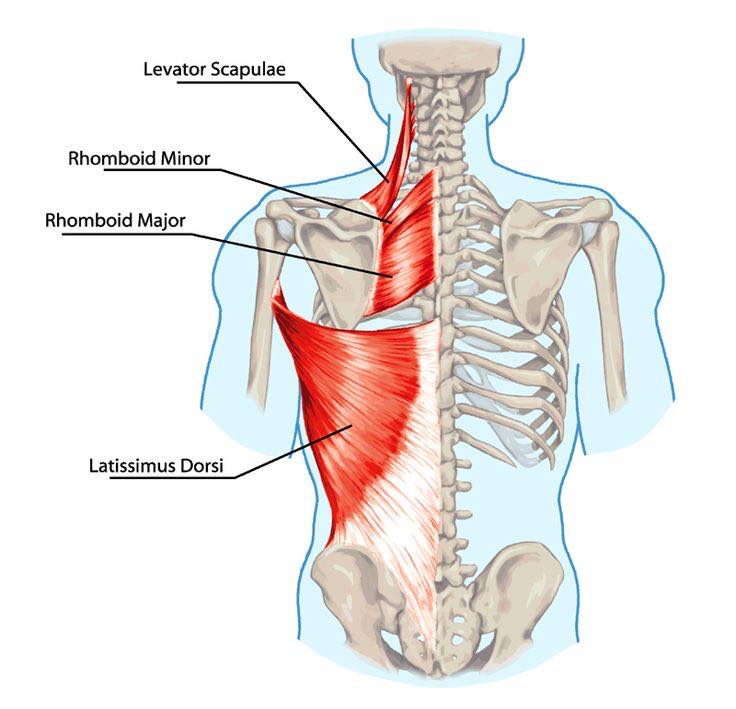
Conclusion
These dumbbell lat exercises and workout plans are great for anyone who wants to widen their back and build strength.
The exercise allows for targeted lat muscle development and provides a massive back look. It is easy to do and requires no more scientific details or fancy equipment.
Be smart: don’t limit yourself to dumbbell exercises. Use other lat exercises, such as cable, bodyweight, and barbell lat exercises, to complement them and get the most out of them.
References
- Krzysztofik, M.; Wilk, M.; Wojdała, G.; Gołaś, A. Maximizing Muscle Hypertrophy: A Systematic Review of Advanced Resistance Training Techniques and Methods. Int. J. Environ. Res. Public Health 2019, 16, 4897.
- Lehman, G. J.; Buchan, D. D.; Lundy, A.; Myers, N.; Nalborczyk, A. Variations in muscle activation levels during traditional latissimus dorsi weight training exercises: An experimental study. Dyn. Med. 2004, 3, 4.

Manish is a NASM-certified fitness and nutrition coach with over 10 years of experience in weight lifting and fat loss fitness coaching. He specializes in gym-based training and has a lot of knowledge about exercise, lifting technique, biomechanics, and more.
Through “Fit Life Regime,” he generously shares the insights he’s gained over a decade in the field. His goal is to equip others with the knowledge to start their own fitness journey.

